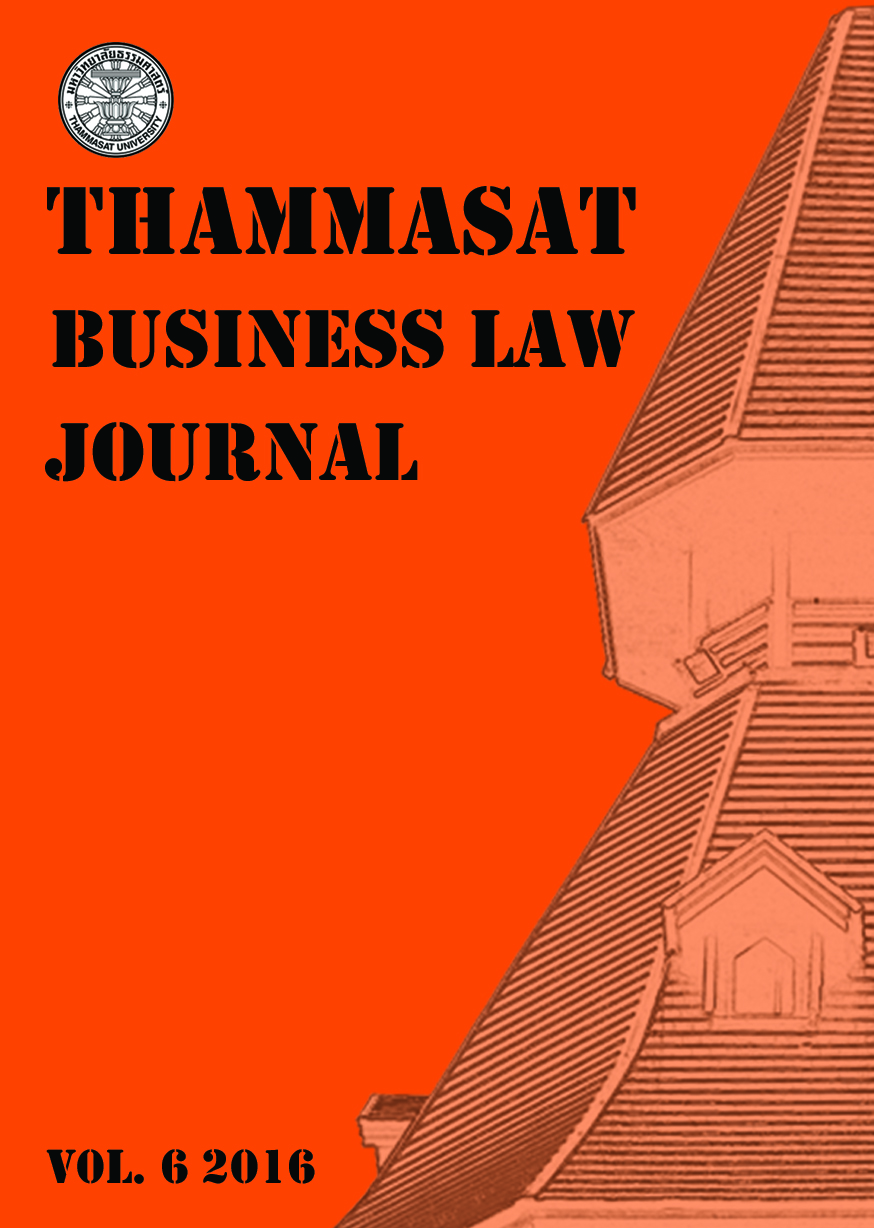MUSICAL WORKS : GUIDELINES FOR ANALYSIS OF COPYRIGHT INFRINGEMENTS IN RELSTION TO MUSICAL WORKS
Main Article Content
Abstract
This article intends to study musical works with a particular focus on musical notes in order to suggest some guidelines for copyright infringement analysis. One of the most complicate issues is “substantial similarity” in the concept of fair use since the unique nature of music makes the analysis more complicate than other copyright works. In other words, the analysis of musical disputes requires much more factors than legal knowledge. Therefore, the study of musical works should not only be based on legal analysis but musical knowledge should be applied to cases as well.
It is the author’s view that in order to make the copyright analysis easier to understand, the music should be separated into three fundamental parts. The first part is the “Melody Part”, which is the most outstanding and important part of the song. This part appears frequently in decisions of the courts. The next part is the “Harmony Part” that usually goes along with the melody part. The last but not least is the “Rhythm Part”. Moreover, in order to analyse cases along with the musical theory, the study will classify cases as “Melody Part Analysis”, “Harmony Part Analysis” and “Rhythm Part Analysis”. Furthermore, the author would like to discuss two musical techniques of the original work arrangement, transposition and variation.
Article Details
References
Cornish, W.R.. Materials on Intellectual Property. Oxford : ESC Publishing Limited, 1990.
Dworkin, Gerald and Taylor, Richard D. Blackstone’s Guide to the Copyright, Designs & Patents Act 1988. Oxford : Oxford University Press, 2002.
Improvisation workbook for piano grade 6-7. Yamaha Music Foundation. Japan 2003
MacQueen, Hector, Waelde, Charlotte, Laurie, Graeme, and Brown, Abbe. Contemporary Intellectual Property Law and Policy. Oxford : Oxford Press, 2010.
Pancharoen, Natchar. Musical Theory. Bangkok : Katecarat Press, 2011.
Parker, Nigel. Music Business. London : Sweet & Maxwell Limited, 2004.
Stokes, Simon. Art and Copyright. United Kingdom : Hart Publishing, 2012.
Subhapholsiri, Dhajjai. Explaination of Copyright Law. Bangkok : Nititham, 1996.
Cadwell, Jeffrey. “Expert Testimony, Scenes a Faire, and Tonal Music A (Not So) New Test for Infringement.” Santa Clara Law Review 46, 1. (2005).
Laroche, Guillaume. “Striking Similarities: Toward a Quantitative Measure of Melodic Copyright Infringement.” Intégral 25 (2011).
Margit, Livington. and Joseph, Urbnato. “Copyright Infringement of Music: Determining Whether What Sounds Alike Is Alike”. Vanderbil Journal of Entertainment and Technology Law 15, 2. (November 2013).
Meek, Maecellus R.“International copyright and musical compositions”. De Paul Law Review 3, 1. (1953).
Sherman, Jeffery G. “Musical Copyright Infringement: The Requirement of Substantial Similarity.” Harvard Law School (1972).
Stav, Iyar. “Musical plagiarism: a true challenge for the copyright law.” Journal of Art, Technology & Intellectual Property Law 25, 1. (2014).
“Infringement of Musical Copyright”. The John Marshall Law Quarterly (1983).
Electronic Media
Bowker, Richard Roger. Copyright Its History and Its Law (1912). available at
https://archive.org/stream/copyrightitshis00bowkgoog#page/n4/mode/2up
(last visited Mar. 7, 2016).
Earmaster available at http://www.earmaster.com/music-theory-online/ch01/chapter-
1-1.html# m10941 (accessed 11 June 2016).
Savage, Mark. “British music industry boosts economy by £4.1bn", Nov. 5, 2015
available at http://www.bbc.com/ news/entertainment-arts-34722928 (last visited Mar. 7, 2016).
Williams, Victoria. “Grade Five Music Theory - Lesson 8: Transposing”, My Music
Theory, available http://www.mymusictheory.com/for-students/grade-5/54-8-transposing (last visited Jun. 15, 2016).
“Arpeggio”, Music Copyright Infringement Resource, available at
http://mcir.usc.edu/glossary/A-F/Pages/arpeggio.html (last visited Mar. 7, 2015).
“Carnival in Cotton Town”, Music Copyright Infringement Resource, available at
http://mcir.usc.edu/cases/1940-1949/Documents/carnivalincottontown.pdf
(last visited Mar. 7, 2015).
“Confessing”, Music Copyright Infringement Resource, available at
http://mcir.usc.edu/cases/1930-1939/Documents/confessingscore.pdf (last visited Mar. 7, 2015).
“Copyright and Fair Use”, Harvard University, available at http://ogc.harvard.edu
/pages/copyright-and-fair-use (last visited Mar. 7, 2016).
“da capo”, about, available at http://piano.about.com/od/musicaltermsa1/g/GL_
daCapo.htm(last visited Mar. 7, 2015).
“dal segno”, about, available athttp://piano.about.com/od/musicaltermsa1/g/GL_
dalSegno.htm (last visited Mar. 7, 2015).
“Dardanella”, Music Copyright Infringement Resource, available at
http://mcir.usc.edu/cases/1920-1929/Documents/dardanellascore.pdf (accessed Mar. 7, 2015).
“Drummer Boy”, Music Copyright Infringement Resource, available at
http://mcir.usc.edu/cases/1940-1949/Documents/carnivalincottontown.pdf
(accessed Mar. 7, 2015).
“FAQ: What’s a Capo?”, Pluck and Play Guitar, available at
http://www.pluckandplayguitar.com/whats-a-capo.html (accessed Jun. 15, 2016).
“Fretboard with notes”, Guitar-Chord.Org, available at http://www.guitar-
chord.org/transposition-chart-for-capo.html (accessed 15, 2016).
“Harmony”, Music Copyright Infringement Resource, available at
http://mcir.usc.edu/glossary/G-L/Pages/harmony.html (last visited Mar. 7, 2015).
“Harmonic Progression” available at http://www.jkornfeld.net/harmonic_
progressions_long.pdf (accessed Sept. 10, 2015).
“I Think I Hear a Woodpecker”, Music Copyright Infringement Resource, available at
http://mcir.usc.edu/cases/1920-1929/Documents/woodpeckerscore.pdf (accessed Mar. 7, 2015).
“International copyright law-The Berne Convention”, The UK Copyright Service,
available at http://www.copyrightservice.co.uk/copyright/p08_berne _convention (accessed Mar. 7, 2016).
“Maria Cahill's Arab Love Song”, Music Copyright Infringement Resource, available
at http://mcir.usc.edu/cases/1920-1929/Documents/arablovesongscore.pdf
(accessed Mar. 7, 2015).
“Melody”, Music Copyright Infringement Resource, available at
http://mcir.usc.edu/glossary/M-R/Pages/Melody.html (accessed Mar. 7, 2015).
“Notation Software and Determination of Melodic Similarity”, Music Copyright
Infringement Resource, available at http://mcir.usc.edu/newtechnologies/Pages /page2 .html (accessed Mar. 7, 2015).
“Starlight”, Music Copyright Infringement Resource, available at http://mcir.usc.edu
/cases/ 1930-1939/Documents/starlight.pdf (accessed Mar. 7, 2015).
“Swanee River Moon”, Music Copyright Infringement Resource, available at
http://mcir.usc.edu/cases/1920-1929/Documents/swaneerivermoonscore.pdf (accessed Mar. 7, 2015).
“The Staff, Treble Clef and Bass Clef”, Music Theory, available at
http://musictheoryblog.blogspot.com/2006/12/staff.html (accessed Mar. 7, 2015).
“Transposition chart for capo”, Guitar-Chord.Org, available at http://www.guitar-
chord.org/transposition-chart-for-capo.html (accessed Jun. 15, 2016).
“Wedding Dance Waltzes”, Music Copyright Infringement Resource, available at
http://mcir.usc.edu/cases/1920-1929/Documents/weddingdancewaltzscore.pdf (accessed Mar. 7, 2015).
“What are intellectual property rights?”, available at http://www.ukabc.org/TRIPs
/intro_WTO.htm (accessed Mar. 7, 2016).


